In the relentless battle against waste – be it plastic offcuts, confidential documents, obsolete electronics, or garden trimmings – size isn’t always the ultimate weapon. For countless workshops, small businesses, offices, farms, and even dedicated home recyclers, the single-motor shredder stands as a testament to the power of focused efficiency. This unassuming workhorse, built around one powerful electric motor, delivers a compelling blend of performance, affordability, and compact reliability that makes industrial-grade shredding accessible where space and budget are critical factors. Forget the misconception that power requires complexity; the single-motor design proves that focused force, intelligently applied, can be remarkably effective.
Unpacking the Heart: The Single-Motor Advantage
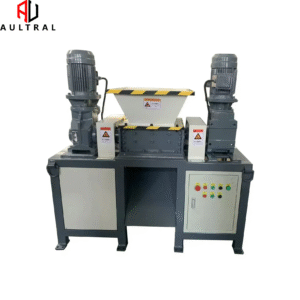
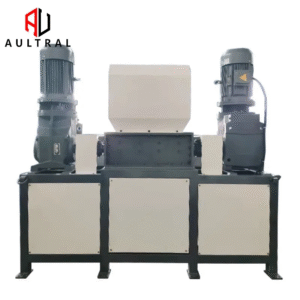
At its core, the single-motor shredder is an exercise in elegant engineering simplicity. Unlike larger, multi-motor industrial behemoths designed for continuous, high-volume throughput, this design channels all its power through a single, robust electric motor. This fundamental choice unlocks several key advantages:
-
Significant Cost Reduction: This is often the primary driver. Eliminating multiple motors, their associated complex drive trains, couplings, and sophisticated control systems drastically reduces manufacturing costs. This saving is passed directly to the end-user, making robust shredding technology attainable for smaller operations and tighter budgets. The initial investment hurdle is significantly lower.
-
Simplified Operation & Maintenance: Fewer moving parts inherently mean fewer things that can go wrong. Operators appreciate the straightforward nature: typically one main power switch, one motor to monitor, and one primary drive system to maintain. Lubrication points are reduced, belt tensioning (if used) is simpler, and overall system diagnostics become less complex. Downtime is minimized, and maintenance personnel don’t require specialized multi-drive expertise.
-
Compact Footprint: With only one motor housing and a potentially simpler gearbox/drive configuration, single-motor shredders boast a significantly smaller physical footprint compared to dual-motor equivalents of similar throat size or rotor diameter. This is invaluable in crowded workshops, retail backrooms, mobile recycling units, or any location where floor space is premium.
-
Energy Efficiency (Focused): While a large multi-motor machine might have a higher total power rating, a well-designed single-motor shredder operates near its optimal load point for its intended duty cycle. There’s no inherent energy drain from idling secondary motors or complex synchronizing systems. For intermittent or moderate-volume shredding tasks, the overall energy consumption per kilogram processed can be very competitive.
-
Robustness & Reliability: A single, high-quality motor driving a well-engineered rotor system through a robust gearbox or direct drive can be incredibly durable. The reduced complexity translates directly into increased mean time between failures (MTBF) when used within its design parameters.
Understanding the Mechanics: How Power Gets Delivered
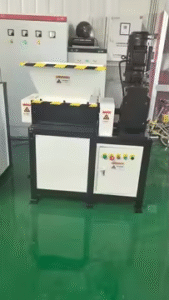
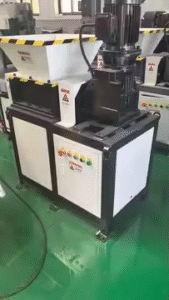
The single motor’s output needs to be effectively transmitted to the shredding rotors. This is achieved through critical drivetrain components:
-
Gearboxes: The most common method. A heavy-duty industrial gearbox (often helical or helical-bevel) steps down the motor’s high RPM to the lower, high-torque RPM required by the shredding rotors. This is crucial for generating the immense twisting force needed to shear and tear materials. Gearboxes are known for their efficiency and power transmission reliability but require regular lubrication.
-
Belt Drives: Some designs utilize heavy-duty industrial V-belts or synchronous belts (like timing belts). This offers some vibration damping and can be slightly cheaper initially. However, belts require tensioning, wear over time, and can slip under extreme load, potentially limiting peak torque delivery compared to a direct gearbox. Maintenance frequency is generally higher.
-
Direct Drive: Less common for smaller shredders due to cost and size, but offers maximum efficiency and eliminates transmission losses. The motor shaft is directly coupled to the rotor shaft. This demands a very low-speed, high-torque motor, which can be expensive. Often seen in higher-end or specialized compact units.
The choice of drivetrain significantly impacts performance characteristics like starting torque, overload capacity, and maintenance needs. Gearboxes generally provide the most consistent and reliable high-torque delivery for demanding shredding tasks.
Where the Single-Motor Shredder Reigns Supreme: Ideal Applications
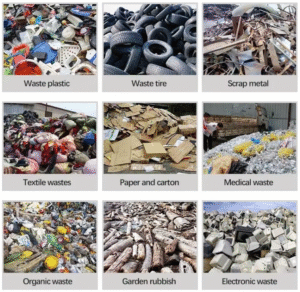
Don’t mistake “single-motor” for “underpowered.” These machines excel in specific, vital niches:
-
Plastic Recycling (Small-Scale): Perfect for shredding PET bottles, HDPE containers, PP caps, LDPE film (within limits), ABS rejects, nylon scraps, and sprues/runners from injection molding. Essential for volume reduction before washing or pelletizing in micro-to-small recycling setups.
-
Document Destruction (Medium Security): Effectively destroys sensitive paper records, CDs/DVDs, and even credit cards to P-2/P-3 security levels (cross-cut), meeting compliance needs for offices, clinics, and government departments without requiring massive, expensive shredders.
-
E-Waste Pre-Processing: Crucial for breaking down old computers, printers, small appliances, keyboards, and circuit boards (often requiring hardened blades) into smaller fragments for subsequent separation and recovery of metals and components. Handles moderate volumes efficiently.
-
Wood & Biomass Processing: Shredding pallet wood offcuts, branches, garden waste, bark, and other clean wood/biomass for composting, biomass fuel production (pellets/briquettes), animal bedding, or landfill diversion. Ideal for arborists, landscapers, and small farms.
-
Textile Recycling: Reducing volumes of pre-sorted post-consumer textiles or manufacturing offcuts for downcycling or further processing.
-
General Industrial Scrap: Handling non-ferrous metal turnings (aluminum, brass), thin sheet metal offcuts, rubber scraps, packaging materials (cardboard, foam), and other miscellaneous waste streams common in workshops and small factories.
Choosing Your Champion: Key Selection Criteria
Selecting the right single-motor shredder is paramount for satisfaction and longevity. Consider these factors carefully:
-
Material Type & Characteristics: What are you shredding? Hard plastics? Tough wood? Fibrous paper? Thin metal? Abrasive composites? This dictates the required rotor design (scissor-cut, shear-cut, staggered hook), blade material (tool steel, D2, D3, HSS, carbide-tipped), and blade hardness (HRC). Harder, more abrasive materials demand hardened or carbide blades and robust rotors.
-
Material Size & Feedstock Form: What size pieces go in? Large sheets? Long pipes? Bundled paper? Bulk bottles? This determines the necessary hopper/throat size and feed mechanism (gravity, ram assist – less common on small single-motor, pusher).
-
Desired Output Size: How small do you need the shredded material? Coarse fragments for volume reduction? Fine granules for recycling? Security-level particles? This influences the screen size (if applicable) and the rotor design/blade gap.
-
Required Throughput (kg/hour): How much material do you need to process daily/weekly? Be realistic. Overloading a shredder designed for intermittent use will lead to premature failure. Match the machine’s rated capacity and duty cycle (e.g., 30 mins on / 30 mins off vs. continuous) to your actual needs.
-
Power & Torque: What motor power (kW/HP) is needed? This is directly linked to the materials and throughput. Shredding hard, thick materials requires significantly more power and torque than shredding paper or film. Low-speed, high-torque motors are essential for shredding. Don’t just look at HP; understand the torque curve.
-
Construction & Build Quality: Is it built to last? Look for thick steel frame/welds, robust bearings (preferably oversized), high-quality drivetrain components (gearbox rating), and accessible service points. Weight can be a good indicator of material robustness.
-
Safety Features: Non-negotiable. Ensure emergency stop buttons, electrical safety interlocks (preventing operation with hopper open), overload protection (mechanical or electrical shear pins/electronic cut-off), and stability are present. CE/UL or other relevant certifications are vital.
-
Ease of Maintenance: Can you access blades for sharpening/rotation? How easy is it to clear jams? Lubricate bearings? Replace wear parts? Good design prioritizes serviceability.
Maximizing Performance & Longevity: Operation & Maintenance Best Practices
Your shredder is an investment. Protect it with proper care:
-
Respect the Duty Cycle: Never exceed the manufacturer’s recommended run/rest periods. Continuous operation machines are built differently (and cost more).
-
Feed Material Correctly: Avoid overfilling the hopper. Don’t force material; let the machine draw it in. Remove contaminants (metal, stones, etc.) before feeding. Shred similar materials together.
-
Monitor Load & Sound: Listen for changes in motor sound or straining. If the machine bogs down significantly, stop feeding or reduce feed rate. Use an ammeter if possible to monitor motor load.
-
Regular Lubrication: Follow the manufacturer’s schedule exactly for gearbox oil changes and bearing greasing. This is the lifeblood of the machine.
-
Blade Maintenance: Inspect blades regularly for dulling, nicks, or damage. Rotate or flip blades as per design to ensure even wear. Sharpen or replace blades promptly when performance drops. Dull blades strain the motor and drivetrain excessively.
-
Cleanliness: Keep the machine, especially the hopper and discharge areas, free of debris buildup. Dust and fines can infiltrate bearings and electrical components.
-
Professional Servicing: Schedule periodic inspections by qualified technicians, especially for gearbox oil analysis and bearing checks.
The Future is Focused: Innovation in Single-Motor Design
The single-motor shredder market is far from stagnant. Continuous innovation focuses on:
-
Higher Torque Density Motors: More power and torque from smaller, more efficient motor packages.
-
Advanced Control Systems: Simple PLCs or VFDs (Variable Frequency Drives) for smoother starting, overload protection, and potentially speed control for different materials.
-
Improved Blade Materials & Coatings: Longer-lasting blades handling more abrasive materials.
-
Enhanced Safety Systems: Proximity sensors, automatic reverse on jam, improved guarding.
-
Noise Reduction: Better enclosures and vibration damping for operator comfort, especially in shared spaces.
-
Modular Design: Easier component replacement and potential for add-ons like conveyors.
Why Choose a [Your Brand Name] Single-Motor Shredder? [Replace with your unique selling points]
At Aultra, we understand the unique demands placed on small-scale shredding operations. Our single-motor shredders aren’t just smaller versions of industrial machines; they are meticulously engineered solutions built for real-world challenges:
-
Uncompromising Core: We use only industrial-grade components – high-torque motors, hardened alloy steel gears in robust gearboxes, premium bearings, and supremely durable, replaceable blades (Tool Steel/D2/D3 Standard, Carbide-Tipped Options available).
-
Precision Engineering: Optimized rotor dynamics and blade geometry ensure efficient cutting, reduced vibration, and maximized throughput within the machine’s class.
-
Built for Service: Thoughtful design provides easy access to blades, drive components, and wear parts, minimizing downtime and maintenance costs.
-
Safety First: Comprehensive safety features are integrated as standard, not an afterthought.
-
Right-Sized Solutions: We offer a range of models with varying throat sizes, motor powers (from [X] kW to [Y] kW), and configurations (screen/no screen) to perfectly match your specific material and volume requirements.
-
Expert Support: Backed by knowledgeable technical support and readily available spare parts.
Conclusion: Power, Simplified
The single-motor shredder embodies the principle that effective waste management doesn’t require overwhelming complexity or exorbitant cost. By focusing power through a robust drivetrain onto a well-designed cutting system, these machines deliver exceptional value, reliability, and performance for a vast array of small-to-medium volume shredding tasks. They are the unsung heroes enabling recycling, security compliance, waste reduction, and resource recovery where larger machines are impractical or uneconomical. For businesses and organizations seeking an efficient, affordable, and dependable solution to conquer their specific waste stream, the single-motor shredder remains an incredibly powerful and relevant choice. It proves that in the world of size reduction, sometimes, one powerful heartbeat is all you need to make a significant impact.
